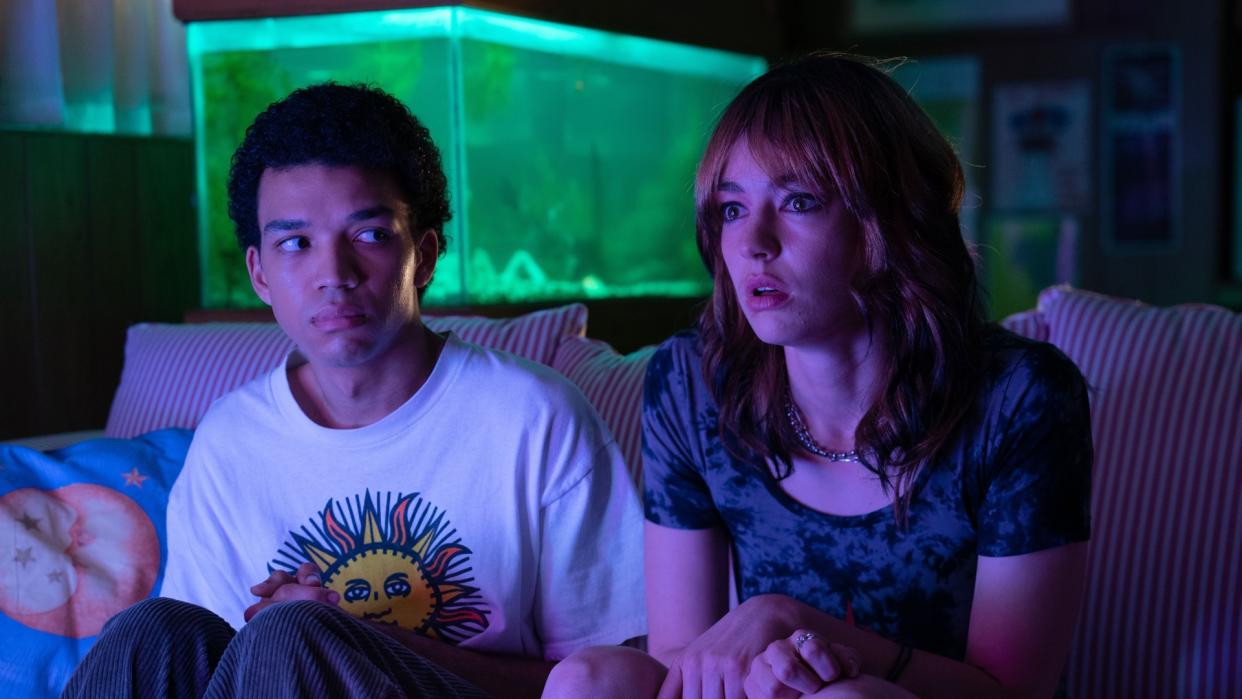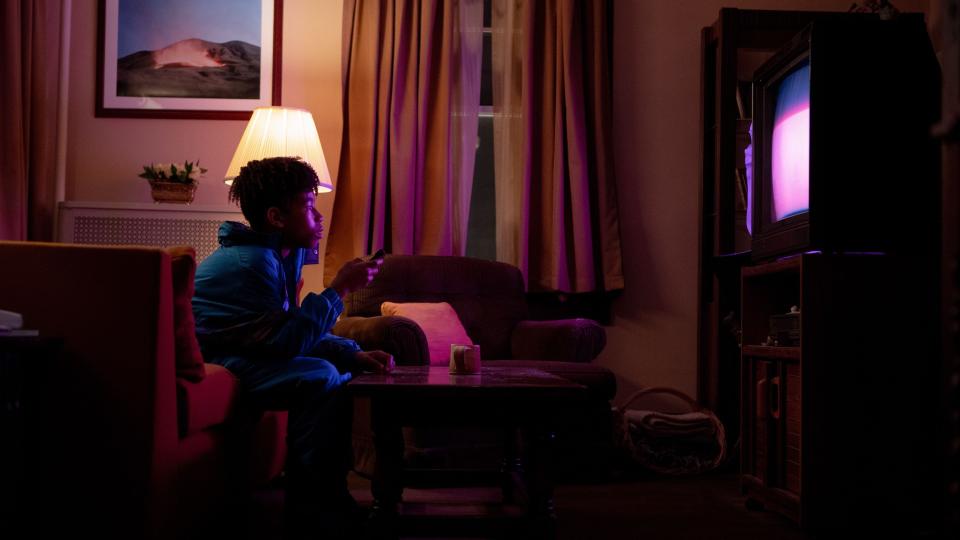2024’s weirdest movie is a haunted flashback for the Nickelodeon generation

- Oops!Something went wrong.Please try again later.
- Oops!Something went wrong.Please try again later.
The characters in Jane Schoenbrun’s haunting new indie reverie I Saw the TV Glow first bond over an episode guide. Not a TV show. The official guide for a TV show. Introverted suburban teenager Owen (Ian Foreman as a 7th grader, Justice Smith thereafter) will eventually become obsessed with The Pink Opaque, a chintzy cable series about two junior-high girls from different towns who forge a psychic bond to battle supernatural forces. But before going full fan, Owen is drawn to the authorized print companion he spots the slightly older Maddy (Brigette Lundy-Paine) flipping through after school.
If you came of age in the 1990s watching shows like The X-Files and Buffy the Vampire Slayer — network watercooler sensations that sat at the intersection of mainstream success and cult appeal — you may well have owned one of these tie-in books, whose glossy pages offered full-color images, tidbits of behind-the-scenes trivia, and summaries of the tangled mythology that connected each weekly installment. Such trusty almanacs of lore were the bibles of late-20th-century fandom. Today, they look like relics of an older era, rendered obsolete by the mass hissing of modems. Eventually, all the information contained between their shiny covers could be found at the click of a mouse instead.
That fictional book for a fictional show is just one telling, evocative detail that ties I Saw the TV Glow to a very particular time period. Though the plot ultimately races forward through the years, a significant stretch of it takes place in the late ’90s, specifically 1996 and 1998 – what you could call the heyday of episode guides, right before everyone took their lives and interests online. It’s one thing to accurately capture the look and vibe of a past decade, but Schoenbrun does something more uncanny still: They create a snapshot of a lonely micro moment, the last gasp of analog fandom at the dawn of the internet era.
I Saw The TV Glow | Official Trailer HD | A24
Schoenbrun is fast becoming an expert at plugging into the very soul of a culture. The writer-director’s remarkable first feature, the microbudget We’re All Going to the World’s Fair, told a drama of online preoccupation through the language of viral videos and creepypasta horror. Few movies before or since have better understood the internet as a machine for reinvention. Was the film’s isolated teenage heroine finding or losing herself by plunging down the rabbit hole of role-playing? Was this a story of hard-earned belonging or radicalization? That it’s tough to say is indicative of Schoenbrun’s shrewd ambivalence, though, of course, there was a larger metaphor to be found in the mystery.
I Saw the TV Glow is no more easily classified. Like We’re All Going to the World’s Fair, it tells a tale of transformation — or at least the screaming desire for one — that can’t be filed in one particular aisle of the proverbial video store. In scope, budget, and the name recognition of its cast (Danielle Deadwyler! Conner O’Malley! Fred freakin’ Durst!), the film is a step forward — even an inch toward the A24 mainstream. Subculturally speaking, it looks backwards: Having made one of the quintessential movies about the internet, Schoenbrun has now returned to an America yet to fully migrate online. Was this the last moment in history when it was possible to feel truly alone in your media obsessions, when you could still feel like they belonged only to you?
Schoenbrun is old enough to recognize that, back then, pop culture was somehow both more ephemeral and more tangible. Before streaming made time slots obsolete, following along with a densely mythological small-screen saga like The Pink Opaque meant ritualistically tuning in when it aired. That, or finding someone to tape it for you. In I Saw the TV Glow, Owen and Maddy form an intimate two-person fan club around physical media — first an episode guide, then a VHS treasure trove of reruns and new installments she passes off to him each week. In the same way that owning a mixtape you could hold in your hands connected you to the songs, these cable recordings become cherished objects for Owen, his personal library of replayable favorites.

The filmmaker has cited their early devotion to Buffy as a key influence, and there’s also a fair amount of Twin Peaks in the doomy-surreal atmosphere of I Saw the TV Glow. (Scenes set at a local watering hole boasting live performances by hip artists like Phoebe Bridgers and King Woman echo both seminal series.) But the film seems even more indebted to a less “cool” touchstone: the adolescent gateway programming of live-action Nickelodeon fare like the kid-horror anthology Are You Afraid of the Dark?, the high-school superhero soap The Secret World of Alex Mack, and the truly offbeat teen sitcom The Adventures of Pete & Pete. Schoenbrun communes with the last of those most clearly: The spirit of Pete & Pete is there via a late pair of cameos, some fourth-wall-breaking narration, a general air of late-summer melancholia, and even the prominent involvement of an ice cream truck driver.
But the film isn’t after an easy hit of nostalgia. It’s not a “things only ’90s kids remember” Buzzfeed listicle. By Schoenbrun’s estimation, our early pop culture obsessions are inherently personal. This was perhaps especially true in a time before the web took fan culture global: Without instant access to the thoughts of thousands of true believers, we forged our own special, weird relationships to our weekly small-screen appointment viewing. This kind of intense connection could distort the story in question, too. One of the most remarkable scenes in I Saw the TV Glow reveals the distance separating Owen’s awed, terrified, highly subjective memory of The Pink Opaque and what the show really was. If anything, the film is about the things ’90s kids misremember.
Schoenbrun hasn’t been shy about the queer subtext. “I’m not making movies to explain being trans to anyone, I’m making movies for trans people,” they said after a recent Chicago screening. However seductively I Saw the TV Glow communicates the general influence formative media can assert on someone’s sense of self, it’s more profoundly and specifically about pop culture fandom as an indirect expression of gender dysphoria: Onto The Pink Opaque does Owen project a deeper longing to uncover the real person inside — an element that takes on undercurrents of tragedy as the film ambles towards its strange, cathartic final scenes. More than any sense of decade-specific displacement, this is what the movie is after at its beating heart.

But like James Joyce, Schoenbrun finds the universal in the particular. I Saw the TV Glow is about transition in multiple respects; it seems to exist in the liminal space between gender identities, yes, but also centuries, cultural movements, life stages, and genres. Like so many films about coming of age in the suburbs, it conveys the special agony of being stuck in a kind of limbo — of being wedged between before and after, here and there, now and later, young and old.
Maybe that feeling is especially acute for elder millennials, the micro generation to which Schoenbrun belongs. We are said to be the only group of people who both grew up with the internet and have vivid memories of life without it. A people who came of age as the world came online. I Saw the TV Glow is tuned to the frequency of our great middle zone, a ghost town of prime-time curiosities and the softcover guides we bought to make sense of them.
I Saw the TV Glow is now playing in select theaters. For more of A.A. Dowd’s writing, visit his Authory page.

